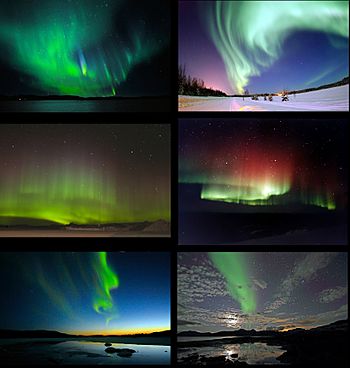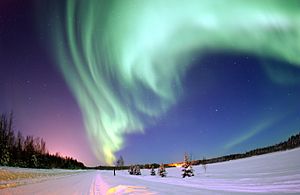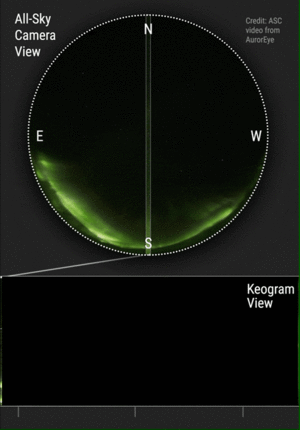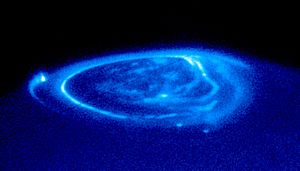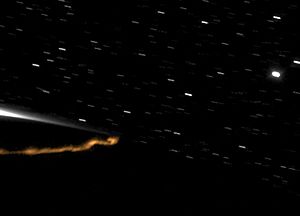Aurora facts for kids
An aurora, also called polar light, northern light or southern light, is a natural light display in the sky. They are usually seen in the high latitudes (Arctic and Antarctic) regions. Auroras are produced when the Earth's magnetosphere is disturbed by the solar wind.
An aurora around the North Pole is called the Aurora borealis or 'northern lights'. Around the South Pole it is the Aurora australis or 'dawn of the south' or 'southern lights'. It can be seen from long distances, stretching in the sky many hundreds of miles far.
Auroras can happen at any time, however they can only be seen at night because their light is not as strong as the light of day. Faint stars can even be seen through the aurora.
Many legends are associated with the aurora in all countries where this phenomenon regularly occurs.
Contents
Etymology
The term aurora borealis was coined by Galileo in 1619, from the Roman Aurora, goddess of the dawn and the Greek name for the north wind (Boreas).
The word aurora is derived from the name of the Roman goddess of the dawn, Aurora, who travelled from east to west announcing the coming of the sun.
The words borealis and australis are derived from the names of the ancient gods of the north wind (Boreas) and the south wind (Auster) in Greek mythology.
Occurrence

Most auroras occur in a band known as the "auroral zone", which is typically 3° to 6° (approximately 330–660 km) wide in latitude and between 10° and 20° from the geomagnetic poles at all local times (or longitudes), most clearly seen at night against a dark sky. A region that currently displays an aurora is called the "auroral oval", a band displaced by the solar wind towards the night side of Earth.
In northern latitudes, the effect is known as the aurora borealis or the northern lights. The southern counterpart, the aurora australis or the southern lights, has features almost identical to the aurora borealis and changes simultaneously with changes in the northern auroral zone. The aurora australis is visible from high southern latitudes in Antarctica, Chile, Argentina, South Africa, New Zealand and Australia. The aurora borealis is visible from areas around the Arctic such as Alaska, the Canadian Territories, Iceland, Greenland, Norway, Sweden, Finland, Scotland, and Siberia. On rare occasions the aurora borealis can be seen as far south as the Mediterranean and the southern states of the US.
How it happens
An aurora occurs when the Sun sends off small particles into space. These particles are mainly electrons, with charge and energy, which means they contribute to electricity. Earth has a protective shield of energy around it. This is called the "magnetic field" and forms an elongated sphere around the Earth called the "magnetosphere". The Earth’s magnetic field keeps off most of the solar wind.
At high-latitude areas (polar areas), the magnetic field is vertical. It does not keep off particles of the solar wind which can come from the magnetosphere and hit the particles of the air (Earth's atmosphere). When they hit, the atmosphere is heated and excited and the excess energy gets away, a phenomenon which we see as moving lights in the sky above 100 km altitude typically. An aurora can be especially bright following a solar flare and coronal mass ejection (CME), when the charged particles rip through the electromagnetic field because of their power.
Colors
- Red: Scarlet, crimson, and carmine are the most often-seen hues of red for the auroras.
- Green
- Blue
- Ultraviolet
- Infrared
- Yellow and pink are a mix of red and green or blue. Other shades of red, as well as orange, may be seen on rare occasions; yellow-green is moderately common.
Changes with time
Auroras change with time, over the night they begin with glows and progress towards coronas, although they may not reach them. They tend to fade in the opposite order. Until about 1963 it was thought that these changes are due to the rotation of the Earth under a pattern fixed with respect to the Sun. Later it was found by comparing all-sky films of auroras from different places (collected during the International Geophysical Year) that they often undergo global changes in a process called auroral substorm. They change in a few minutes from quiet arcs all along the auroral oval to active displays along the darkside and after 1 – 3 hours they gradually change back. Changes in auroras over time are commonly visualized using keograms.
At shorter time scales, auroras can change their appearances and intensity, sometimes so slowly as to be difficult to notice, and at other times rapidly down to the sub-second scale. The phenomenon of pulsating auroras is an example of intensity variations over short timescales, typically with periods of 2–20 seconds. This type of aurora is generally accompanied by decreasing peak emission heights of about 8 km for blue and green emissions and above average solar wind speeds (c. 500 km/s).
Noise
Aurora noise, similar to a crackling noise, begins about 70 m (230 ft) above Earth's surface and is caused by charged particles in an inversion layer of the atmosphere formed during a cold night. The charged particles discharge when particles from the Sun hit the inversion layer, creating the noise.
On other planets
Both Jupiter and Saturn have magnetic fields that are stronger than Earth's, and both have extensive radiation belts. Auroras have been observed on both gas planets, most clearly using the Hubble Space Telescope, and the Cassini and Galileo spacecraft, as well as on Uranus and Neptune.
Auroras have also been observed on Venus and Mars. Venus has no magnetic field and so Venusian auroras appear as bright and diffuse patches of varying shape and intensity, sometimes distributed over the full disc of the planet. A Venusian aurora originates when electrons from the solar wind collide with the night-side atmosphere.
An aurora was detected on Mars, on 14 August 2004, by the SPICAM instrument aboard Mars Express. The aurora was located at Terra Cimmeria, in the region of 177° east, 52° south. The total size of the emission region was about 30 km across, and possibly about 8 km high.
Between 2014 and 2016, cometary auroras were observed on comet 67P/Churyumov–Gerasimenko by multiple instruments on the Rosetta spacecraft. The auroras were observed at far-ultraviolet wavelengths.
Exoplanets, such as hot Jupiters, have been suggested to experience ionization in their upper atmospheres and generate an aurora modified by weather in their turbulent tropospheres. However, there is no current detection of an exoplanet aurora.
The first ever extra-solar auroras were discovered in July 2015 over the brown dwarf star LSR J1835+3259. The mainly red aurora was found to be a million times brighter than the northern lights, a result of the charged particles interacting with hydrogen in the atmosphere. It has been speculated that stellar winds may be stripping off material from the surface of the brown dwarf to produce their own electrons. Another possible explanation for the auroras is that an as-yet-undetected body around the dwarf star is throwing off material, as is the case with Jupiter and its moon Io.
Images for kids
See also
 In Spanish: Aurora polar para niños
In Spanish: Aurora polar para niños


